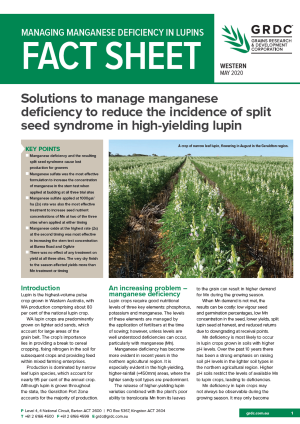Managing manganese deficiency in lupins
Published: 26 May 2020
Key Points
- Manganese deficiency and the resulting split seed syndrome cause lost production for growers
- Manganese sulfate was the most effective formulation to increase the concentration of manganese in the stem test when applied at budding at all three trial sites
- Manganese sulfate applied at 1000gai/ ha (2x) rate was also the most effective treatment to increase seed nutrient concentrations of Mn at two of the three sites when applied at either timing
- Manganese oxide at the highest rate (2x) at the second timing was most effective in increasing the stem test concentration at Burma Road and Ogilvie
- There was no effect of any treatment on yield at all three sites. The very dry finish to the season affected yields more than Mn treatment or timing
Introduction
Lupin is the highest-volume pulse crop grown in Western Australia, with WA production comprising about 80 per cent of the national lupin crop.
WA lupin crops are predominantly grown on lighter acid sands, which account for large areas of the grain belt. The crop’s importance lies in providing a break to cereal cropping, fixing nitrogen in the soil for subsequent crops and providing feed within mixed farming enterprises.
Production is dominated by narrow leaf lupin species, which account for nearly 95 per cent of the annual crop. Although lupin is grown throughout the state, the Geraldton Port Zone accounts for the majority of production.
Region: West
GRDC Project Code: CRC1908-001SAX,
Was this page helpful?
YOUR FEEDBACK

